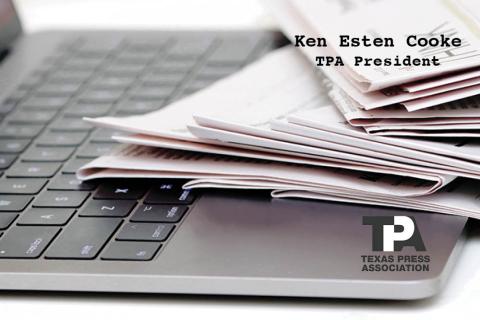Establishing trust in an AI world
By KEN ESTEN COOKE, TPA President, 2023-24
The world seems to be moving at light speed. The somewhat slower pace we used to have at a weekly publication has ramped up exponentially since the dawn of the internet. In addition to our print products, we now publish websites, email newsletters, social media posts, videos, podcasts and more.
The internet and its exchange of instantaneous information has also led to a lot of misinformation as it’s cheap to produce and it spreads like wildfire. So how do we make sure all the bots scouring the World Wide Web for information see our websites as legitimate? How do we separate the digital wheat from the chaff?
TPA Executive Director Mike Hodges and I recently had an online chat with Scott Yates, founder of JournalList (https://journallist.net), which seeks to give our publications and operations a helping hand.
Yates, who is also a former journalist, has come up with a system of helping the digital robots know about groups that have formed to express trust in each other — groups like the Texas Press Association. Those associations or trade groups can encourage their members to install a line of code in their websites — a file called Trust.txt — that states, “This site is a vetted member of the TPA, the state’s historic trade organization, and it’s a legitimate news site.”
“It’s like a Good Housekeeping Seal of Approval, but it’s designed for computers instead of people,” Yates said. “It instills confidence in the news source. The fact that a publication belongs to TPA is important.”
When someone does a search using Google or another engine, the bots reaching out to find the answers to this query will find this “seal of approval” and move it up in the rankings.
In Fredericksburg, our website service provider, eType Services, has had these codes embedded for several years now. Yates also is working on other service providers and is also reaching out to larger news operations like Gannett or McClatchy.
So why do this now? In addition to the good that it did before, it now deals with the advent of Artificial Intelligence sucking up all of our content and not paying for it. Some background: The Associated Press recently signed an agreement with OpenAI — a leading artificial intelligence company and creator of the ChatGPT software — to do data training. The New York Times, on the other hand, went to court, so AI firms couldn’t freely reference their materials without some sort of compensation. Yates said including the Trust.txt file on your website is a first step and prevents AI robots from training with content from our sites.
We’ll see how all of this develops in coming years, but I, too, believe compensation is needed to cite our legitimate news sites as sources. Surely we can all agree that legitimate sources, the wheat, need to be used with AI and the chaff needs to be deprioritized.
“The response we’ve gotten is really strong,” Yates said, encouraging everyone to get started with the trust.txt process. He said 2023 was a good growth year, and news sites using the website code grew by 1,000 and now number about 4,000.
“It’s a good, easy way to earn legitimacy,” he said. Even if you build your own website, there are Wordpress plug-ins available (with a “how to” at JournalList.net).
Eventually, this could help with the advertising networks as well, many of which want to avoid controversial subjects, but which would give exception to organizations covering the news. Imagine a programmatic ad network that would stress our news sites we all work so hard to produce over clickbait sites that simply get more eyeballs.
It would also root out — or at least lower the search rankings of — sites that are strictly political “pink slime” sites or just advertising click bait.
Yates has credibility in this area as well. He has worked with the Journalism Trust Initiative, and there is another initiative called the Trust Project. Yet both of these operations require a big investment in time and manpower to show your processes of journalism standards, including use of sources, corrections policies, ownership disclosures and much more. While those are good things and something to work toward, getting started with Trust.txt is super simple in comparison.
Yates promises more communication about trust.txt in the coming year. In the meantime, TPA members are already included on the TPA trust.txt file, and we encourage you to either post your own trust.txt file or ask your service provider (or if you are part of a media group ask your web team) to add the file to your site. If you have questions, you can contact Scott at scott@journallist.net.
It’s all free to you. The TPA, thanks to Mike Hodges, has already paid the fee for all member papers to be included. In these days of our legitimate sites sometimes being overshadowed by misinformation, let’s make sure our sites rise to the challenge — and the top of the search rankings — by installing the Trust.txt file.
What I’m Reading
Along the lines of establishing trust, “Tell It Like It Is: A Guide to Clear and Honest Writing,” by Roy Peter Clark. I just received this, but highly recommend any of the books by Clark, who is a vice president at the Poynter Institute. “Writing Tools” and “How to Write Short” would be great gifts for anyone in your newsroom.
Please connect on LinkedIn, Facebook, Instagram, Threads or X (@kenestencooke), or email me at ken@fredericksburgstandard.com.
- Log in to post comments

